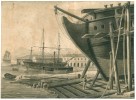[DESSIN AU LAVIS D'ENCRE - SCENE DE VIE D'ARSENAL VERS 1800 / INK WASH DRAWING - ARSENAL LIFE SCENE CIRCA 1800].
s.l.n.d., circa 1800. 1800 1 feuille (192 x 270 mm), dessin au lavis d'encre noire. (Quelques taches claires ou rousseurs).
Reference : 4696
Superbe dessin au lavis d'encre représentant une scène de vie d'un arsenal vers 1800.En France, le dessin de marine est une tradition qui remonte a la fin du XVIIe siècle. La constitution d'une flotte militaire de premier plan sous l'impulsion de Louis XIV et de son ministre Colbert pousse des marins à devenir artistes afin de représenter ces navires de façon plus réaliste que les scènes nautiques dues aux artistes généralistes dalors. Au XVIIIe siècle, des dessinateurs de marine tels que Nicolas Ozanne (1728-1811) et son frère Pierre (1737-1813) poussent cet art à son plus haut niveau. Leurs dessins sont gravés et illustrent les traités de navigation, de construction navale ou d'histoire maritime. Le présent dessin, exécuté dans les années 1800-1820, nest pas signé. Il présente la finesse et les qualités des travaux des Ozanne et est certainement l'uvre d'un de leurs élèves ou d'un continuateur de cet art qui connait d'autres maitres actifs au XIXe siècle tels que Jean Jérôme Baugean (1765-1830) ou Léon Morel-Fatio (1810-1871). Au premier plan de dessin exécuté au lavis dencre se dresse limposante étrave dun navire déjà gréé, prêt à la mise à leau. Au pied, sur le plan incliné, un charpentier portant un madrier nous donne une bonne idée des dimensions de cette unité. Au second plan, une barge aux formes rondes, portant un mat de charge et un cabestan, est amarrée devant un second navire à moitié gréé, à quai face à des bâtiments darsenal aux toitures de tuiles qui pourraient être ceux du port-arsenal de Toulon. Des silhouettes saffairent sur son pont et une chaloupe amarrée a sa poupe semble le faire manuvrer. En arrière-plan à gauche, un troisième navire est représenté toutes voiles dehors, létrave pointée vers lentrée du port. Au fonds se dessine la silhouette de hautes collines ou montagnes. Lartiste a intentionnellement représenté chaque détail des pièces de bois constituant létrave du premier navire : chaque clou maintenant le bordage aux membrures est même représenté. Ce dessin était probablement destiné à illustrer un traité de construction navale. Nous avons trouvé des dessins très similaires dans le traité du gréement de Pierre-Alexandre Forfait (1752 - 1807), publié en 1788 1 sheet (192 x 270 mm), drawing in black ink wash. (Some light stains or foxing). Superb ink wash drawing representing a scene of life in an arsenal around 1 800. In France, maritime design is a tradition that dates back to the end of the 17th century. The constitution of a leading military fleet under the impetus of Louis XIV and his minister Colbert pushed sailors to become artists in order to represent these ships in a more realistic way than the nautical scenes due to the more generalist artists of the time. In the 18th century, maritime designers such as Nicolas Ozanne (1728-1811) and his brother Pierre (1737-1813) pushed this art to its highest level. Their engraved drawings illustrate treatises on navigation, shipbuilding and maritime history. This drawing, made in the years 1800-1820, is unsigned. However, it presents the finesse and qualities of the works of the Ozannes and is certainly the drawing of one of their students or of a continuator of their art who knows other masters from the 19th century such as Jean Jérôme Baugean (1765-1830 ) or Léon Morel-Fatio (1810-1871). In the foreground of this drawing executed in ink wash stands the imposing bow of an already rigged ship, ready for launching. At the foot, on the inclined plane, a carpenter carrying a plank gives us a good idea of the dimensions of the ship. In the background, a round-shaped barge, carrying a load mast and a capstan, is moored in front of a second half-rigged ship, at the quay facing the arsenal buildings with tiled roofs which could be those of the port-arsenal from Toulon. Silhouettes cluster on its deck and a rowboat moored at its stern seems to be maneuvering it. In the background to the left, a third ship is shown with full sails out, the bow pointed towards the entrance of the port. In the background, the silhouette of high hills or mountains emerges. The artist intentionally represented every detail of the pieces of wood constituting the bow of the first ship: every nails holding the planking to the frames are even represented. This drawing was probably intended to illustrate a treaty on shipbuilding. We found very similar designs in Pierre-Alexandre Forfait's Treatise on Rigging (1752 - 1807), published in 1788.
Bookseller's contact details
J-F Letenneur Livres Rares
M. Jean-François Letenneur
11 bd du tertre Gondan
35800 Saint Briac sur Mer
France
librairie@jfletenneurlivresrares.fr
06 81 35 73 35
 Write to the booksellers
Write to the booksellers

